人教版(2019)必修第一册Unit4 Natural Disasters Video Time 课件(共23张PPT)
文档属性
| 名称 | 人教版(2019)必修第一册Unit4 Natural Disasters Video Time 课件(共23张PPT) | 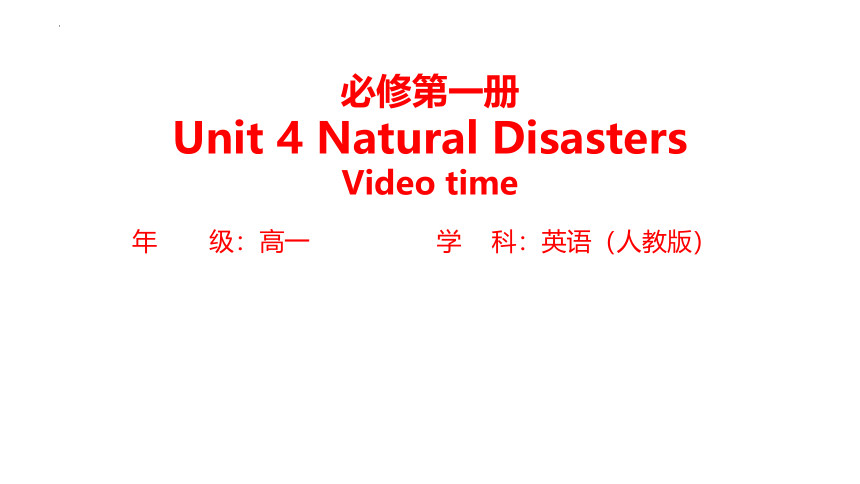 | |
| 格式 | pptx | ||
| 文件大小 | 17.8MB | ||
| 资源类型 | 教案 | ||
| 版本资源 | 人教版(2019) | ||
| 科目 | 英语 | ||
| 更新时间 | 2024-04-10 14:20:21 | ||
图片预览


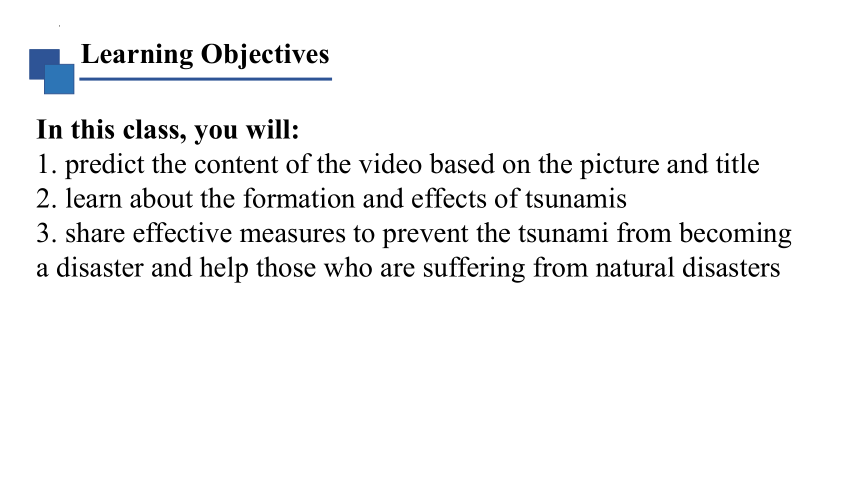
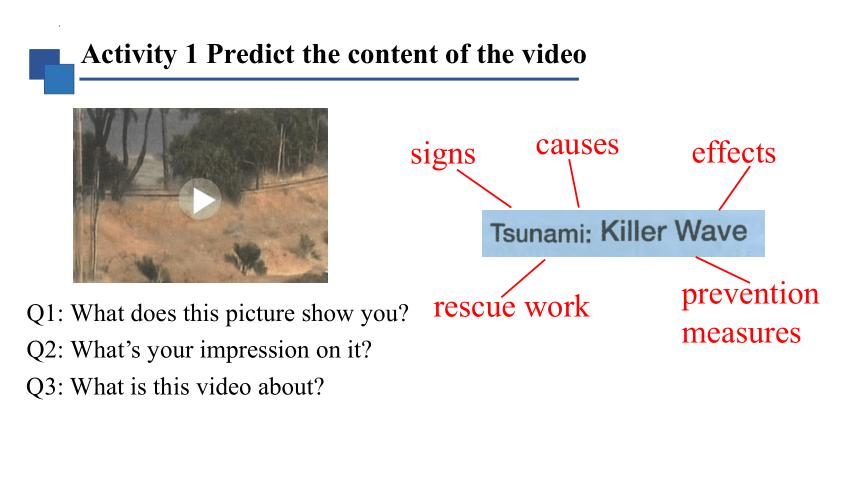
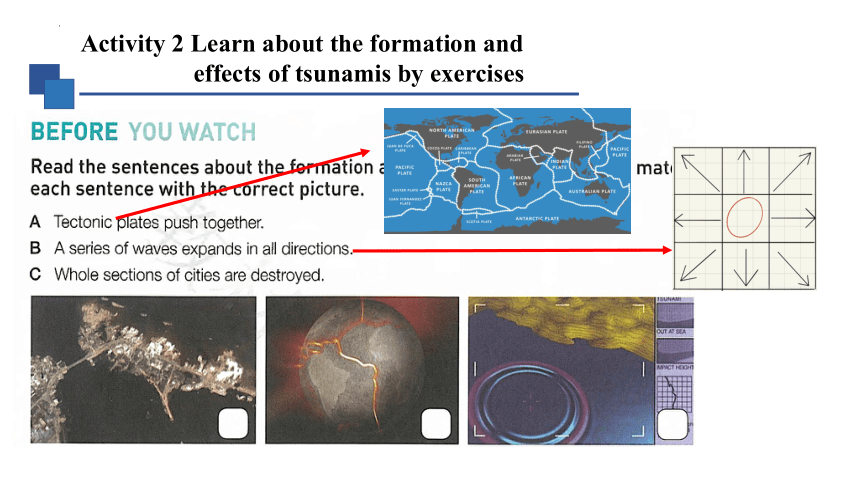
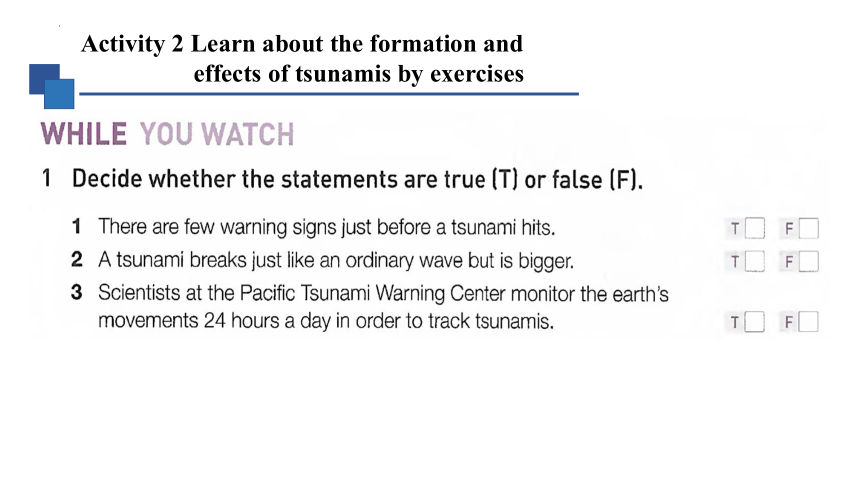


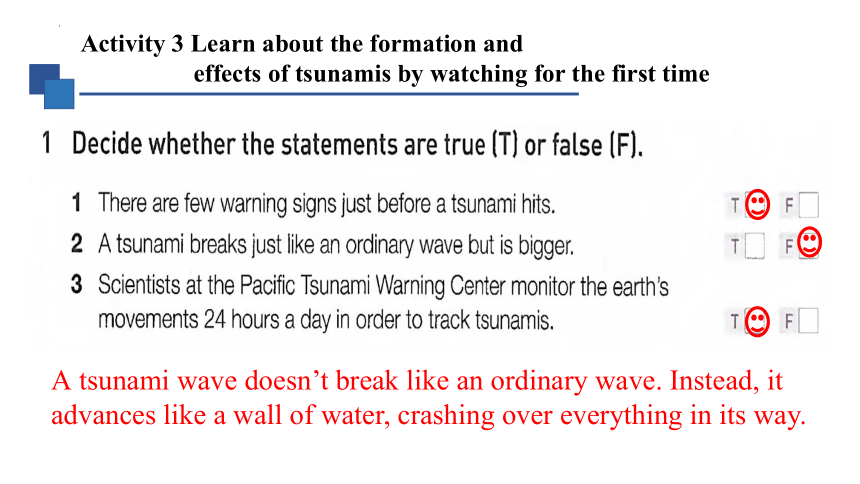
文档简介
(共23张PPT)
必修第一册
Unit 4 Natural Disasters
Video time
年 级:高一
学 科:英语(人教版)
Unit 4 Natural Disasters
Kinds of disaster
Preparations for a disaster
(Listening and Speaking)
(Listening and Talking)
(Workbook: expanding your world)
Earthquake
Tsunami
(Reading and thinking)
(Assessing your progress)
(Workbook: Reading and writing)
(Reading for writing)
(Video time)
Learning Objectives
In this class, you will:
1. predict the content of the video based on the picture and title
2. learn about the formation and effects of tsunamis
3. share effective measures to prevent the tsunami from becoming a disaster and help those who are suffering from natural disasters
Activity 1 Predict the content of the video
Q1: What does this picture show you
Q2: What’s your impression on it
Q3: What is this video about
signs
causes
effects
prevention
measures
rescue work
Activity 2 Learn about the formation and
effects of tsunamis by exercises
Activity 2 Learn about the formation and
effects of tsunamis by exercises
Activity 3 Learn about the formation and
effects of tsunamis by watching for the first time
C
A
B
Activity 3 Learn about the formation and
effects of tsunamis by watching for the first time
A tsunami wave doesn’t break like an ordinary wave. Instead, it advances like a wall of water, crashing over everything in its way.
Activity 4 Learn about the formation and
effects of tsunamis by watching for the second time
Activity 4 Learn about the formation and
effects of tsunamis by watching for the second time
1. An earthquake occurs when plates below the earth’s surface push together/pull apart.
Activity 4 Learn about the formation and
effects of tsunamis by watching for the second time
2. Tsunami waves deep at sea move fast and rise only a few/hundreds of feet.
Activity 4 Learn about the formation and
effects of tsunamis by watching for the second time
3. As these killer waves enter shallow waters, their speed is reduced/raised.
Activity 4 Learn about the formation and
effects of tsunamis by watching for the second time
4. Most tsunami damage is caused when the waves come in from/move back out to the sea.
Activity 5 Share effective measures by watching
for the third time
Q1: What have you learnt about tsunamis
Q2: How can we prevent the tsunami from becoming a disaster?
Q3: What kind of help do you think people who have suffered from a tsunami need
Q1: What have you learnt about tsunamis
Activity 5 Share effective measures by watching
for the third time
Q2: How can we prevent the tsunami from becoming a disaster?
Scientists the earth’s movements 24hours a day in order to track tsunamis.
The scientists try to the wave will head and people in its path.
The advice is simple: the coastal areas and to higher ground. news that the danger has .
monitor
find out where
warn
leave
move
Wait for
passed
Activity 5 Share effective measures by watching
for the third time
Q3: What kind of help do you think people who have suffered from a tsunami need
When people are injured,
medical team should be sent there.
When their homes …
When people have no clean water and food,
When …
Activity 5 Share effective measures by watching
for the third time
Homework
You may choose either of them, but don’t forget to use what we have learnt in class.
1. Make a poster to tell people about tsunamis.
2. Make a presentation on tsunamis.
TED: The Science of Tsunamis
https://tv./v/cGwvOTU4NDI3MC8xNTYzMTA3NzAuc2h0bWw=.html vid=156310770&wx=0&channeled=1211020100&aid=9584270&boke=1
Self-Assessment
1. I have learnt some new words and expressions in the video, such as “occur”, “in all direction”, etc.
2. I have applied some listening and viewing strategies such as predicting.
3. I have learnt about the formation and effects of tsunamis.
4. I have learnt more effective measures to prevent the tsunami from becoming a disaster.
5. I have learnt more effective measures to help those who are suffering from natural disasters.
Video Time视频来自于教材
图片来自于教材
必修第一册
Unit 4 Natural Disasters
Video time
年 级:高一
学 科:英语(人教版)
Unit 4 Natural Disasters
Kinds of disaster
Preparations for a disaster
(Listening and Speaking)
(Listening and Talking)
(Workbook: expanding your world)
Earthquake
Tsunami
(Reading and thinking)
(Assessing your progress)
(Workbook: Reading and writing)
(Reading for writing)
(Video time)
Learning Objectives
In this class, you will:
1. predict the content of the video based on the picture and title
2. learn about the formation and effects of tsunamis
3. share effective measures to prevent the tsunami from becoming a disaster and help those who are suffering from natural disasters
Activity 1 Predict the content of the video
Q1: What does this picture show you
Q2: What’s your impression on it
Q3: What is this video about
signs
causes
effects
prevention
measures
rescue work
Activity 2 Learn about the formation and
effects of tsunamis by exercises
Activity 2 Learn about the formation and
effects of tsunamis by exercises
Activity 3 Learn about the formation and
effects of tsunamis by watching for the first time
C
A
B
Activity 3 Learn about the formation and
effects of tsunamis by watching for the first time
A tsunami wave doesn’t break like an ordinary wave. Instead, it advances like a wall of water, crashing over everything in its way.
Activity 4 Learn about the formation and
effects of tsunamis by watching for the second time
Activity 4 Learn about the formation and
effects of tsunamis by watching for the second time
1. An earthquake occurs when plates below the earth’s surface push together/pull apart.
Activity 4 Learn about the formation and
effects of tsunamis by watching for the second time
2. Tsunami waves deep at sea move fast and rise only a few/hundreds of feet.
Activity 4 Learn about the formation and
effects of tsunamis by watching for the second time
3. As these killer waves enter shallow waters, their speed is reduced/raised.
Activity 4 Learn about the formation and
effects of tsunamis by watching for the second time
4. Most tsunami damage is caused when the waves come in from/move back out to the sea.
Activity 5 Share effective measures by watching
for the third time
Q1: What have you learnt about tsunamis
Q2: How can we prevent the tsunami from becoming a disaster?
Q3: What kind of help do you think people who have suffered from a tsunami need
Q1: What have you learnt about tsunamis
Activity 5 Share effective measures by watching
for the third time
Q2: How can we prevent the tsunami from becoming a disaster?
Scientists the earth’s movements 24hours a day in order to track tsunamis.
The scientists try to the wave will head and people in its path.
The advice is simple: the coastal areas and to higher ground. news that the danger has .
monitor
find out where
warn
leave
move
Wait for
passed
Activity 5 Share effective measures by watching
for the third time
Q3: What kind of help do you think people who have suffered from a tsunami need
When people are injured,
medical team should be sent there.
When their homes …
When people have no clean water and food,
When …
Activity 5 Share effective measures by watching
for the third time
Homework
You may choose either of them, but don’t forget to use what we have learnt in class.
1. Make a poster to tell people about tsunamis.
2. Make a presentation on tsunamis.
TED: The Science of Tsunamis
https://tv./v/cGwvOTU4NDI3MC8xNTYzMTA3NzAuc2h0bWw=.html vid=156310770&wx=0&channeled=1211020100&aid=9584270&boke=1
Self-Assessment
1. I have learnt some new words and expressions in the video, such as “occur”, “in all direction”, etc.
2. I have applied some listening and viewing strategies such as predicting.
3. I have learnt about the formation and effects of tsunamis.
4. I have learnt more effective measures to prevent the tsunami from becoming a disaster.
5. I have learnt more effective measures to help those who are suffering from natural disasters.
Video Time视频来自于教材
图片来自于教材
